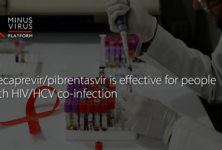Rosuvastatin for 96 weeks significantly slowed progression of subclinical atherosclerosis — as measured by common carotid artery intima-media thickness (CCA-IMT) — in a double-blind placebo-controlled trial. Participants had normal low-density lipoprotein cholesterol (LDL-C) before treatment began, but the statin further lowered LDL-C, according to the study.
Statins remain the cornerstone of therapy for dyslipidemia in people with and without HIV. Because of their antiinflammatory activity, statins have drawn attention as a potential remedy for the chronic inflammation and immune activation that persist in HIV patients with an undetectable viral load. That ongoing inflammation can contribute to cardiovascular disease and an array of other maladies. SATURN-HIV is the first double-blind placebo-controlled trial to assess potential nonlipid benefits of rosuvastatin therapy in people with normal LDL-C. Previously reported SATURN-HIV analyses did document declining markers of inflammation and lymphocyte activation in participants receiving rosuvastatin.
SATURN-HIV recruited HIV-positive adults on stable antiretroviral therapy and with LDL-C at or below 130 mg/dL plus signals of increased inflammation or T-cell activation (high-sensitivity C-reactive protein ≥2 mg/L and/or CD38+HLA-DR+ CD8 cells ≥19%). No one had known coronary disease. Participants underwent carotid ultrasound at baseline and weeks 48 and 96 to measure changes in CCA-IMT. At the same points they had cardiac computed tomography to gauge changes in coronary artery calcium. Standard assays measured biomarkers of inflammation and immune activation throughout the study.
The researchers randomized 72 participants to rosuvastatin (10 mg daily) and 75 to placebo. Respective median ages were 45 and 47, proportions of men 81% and 76%, proportions of blacks 69% and 67% and median Framingham cardiovascular risk scores 3 and 4. Three-quarters of participants in both arms had a viral load below 50 copies/mL. Because nine people randomized to rosuvastatin and 19 randomized to placebo dropped out of the study (none because of drug-related adverse events), the researchers had complete 48-week data on 123 participants (84%) and complete 96-week data on 118 (80%).
An adjusted linear mixed-effects model determined that randomization to rosuvastatin was associated with 0.019 mm lower CCA-IMT (95% confidence interval 0.002 to 0.037) than randomization to placebo (P = .03). The difference between CCA-IMT changes with rosuvastatin versus placebo was significant at 48 weeks (P = .025) and borderline significant at 96 weeks (P = .061). The CCA-IMT difference did not vary substantially by levels of inflammation or immune activation markers.
LDL-C declined by an average 24 mg/dL through week 24 in the rosuvastatin group. This drop from baseline LDL-C persisted through 96 weeks and remained statistically different from LDL-C change in the placebo group at all time points. There was no between-arm difference in coronary artery calcium change through 96 weeks (P = .61).
The SATURN-HIV investigators believe their CCA-IMT findings “suggest that HIV-infected patients are likely to gain a cardiovascular outcomes benefit from statin therapy.” That hypothesis, they note, will be tested in the Randomized Trial to Prevent Vascular Events in HIV (REPRIEVE). The researchers stress that they “did not find definitive evidence of treatment effect modification by inflammation status” but urge further study of that possible correlation in larger clinical endpoint trials.
By Mark Mascolini


 ПОИСК ПО САЙТУ
ПОИСК ПО САЙТУ  поиск по ресурсному центру
поиск по ресурсному центру 



